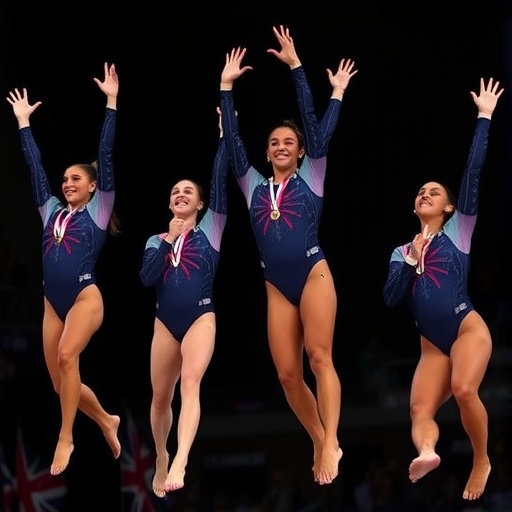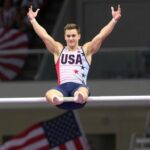U.S. Women’s Gymnasts Dominate Qualifications: All Four Advance to Finals at 2025 World Championships in Jakarta
In a stunning display of talent and resilience, the U.S. women’s Gymnastics team has secured a historic sweep at the 2025 World Gymnastics Championships in Jakarta, with all four competitors—Dulcy Caylor, Leanne Wong, Skye Blakely, and Joscelyn Roberson—advancing to the coveted finals. This flawless qualification round not only boosts America’s medal prospects but also signals a new era of dominance in international Gymnastics, captivating fans worldwide from the vibrant arenas of Indonesia’s capital.
The event, held under the scorching Jakarta sun and the roar of a passionate crowd, saw the U.S. women’s team execute routines that blended precision with artistry, earning top scores across multiple apparatuses. As the dust settles on the qualifications held on October 15, 2025, gymnasts from over 80 nations now turn their eyes to the finals, where the Americans stand poised to reclaim their throne after a competitive Olympic cycle.
Caylor’s Vault Mastery Steals the Spotlight in Jakarta
Dulcy Caylor, the 19-year-old prodigy from California, emerged as the undeniable star of the qualification phase, her vault performance sending shockwaves through the gymnastics community. With a difficulty score of 6.2 on her signature Yurchenko double pike—affectionately dubbed the “Caylor Vault”—she posted a total of 15.233, the highest in the field. This feat not only qualified her for the all-around finals but also positioned her as a frontrunner for individual apparatus gold.
“I’ve been dreaming of this moment since I was a kid flipping on my backyard trampoline,” Caylor said post-competition, her voice steady despite the adrenaline. “Jakarta’s energy is electric—it’s pushing me to new heights.” Her routine, executed with flawless form and explosive power, highlighted years of rigorous training under coach Li Li Zhuang at the World Olympic & Gymnastics Academy. Caylor’s qualification score of 57.866 in the all-around underscores her versatility, making her a key pillar for the U.S. women’s team.
Statistics from the International Gymnastics Federation (FIG) reveal that Caylor’s vault marked the first time an American woman has led the qualification standings since Simone Biles’ iconic 2019 Worlds performance. This achievement is particularly poignant amid the sport’s evolving landscape, where increased difficulty requirements have weeded out all but the most elite athletes. In Jakarta’s humid conditions, which tested endurance like never before, Caylor’s composure was a testament to the U.S. team’s preparation, including simulated tropical training sessions back home.
Experts like former Olympian Nastia Liukin praised Caylor’s poise: “She’s not just athletic; she’s got that rare spark that turns good routines into legendary ones.” As the finals approach, Caylor’s performance sets a benchmark for her teammates, amplifying the excitement for what could be a medal bonanza for American gymnastics.
Wong’s Uneven Bars Brilliance Secures U.S. Team Momentum
Leanne Wong, the 21-year-old University of Florida standout, channeled her collegiate prowess into a masterful uneven bars routine that propelled the U.S. women’s team forward. Scoring 15.466 on bars—a blend of a full-twisting Pak salto and a high-difficulty Tkatchev—she clinched her spot in both the all-around and apparatus finals with an overall qualification tally of 56.999. Wong’s execution, marked by zero deductions for wobbles, showcased the technical finesse that has defined her career since her silver medal win at the 2023 Worlds.
“The bars are my happy place,” Wong shared in a press conference, flanked by her teammates. “Competing in Jakarta feels like a homecoming for our sport’s global spirit—I’m honored to represent the U.S. women’s team here.” Her routine, set to a haunting orchestral score, resonated emotionally with spectators, many of whom waved American flags in solidarity. Wong’s journey to this point included overcoming a nagging shoulder injury during the 2024 Olympic trials, a setback that only fueled her determination.
Delving into the numbers, Wong’s bars score ranked second globally, just behind China’s Ou Yushan, intensifying the rivalry narrative heading into the finals. The U.S. women’s team’s collective qualification success— with no apparatus below 14.0—marks the first time since 2018 that all American entrants have advanced unscathed. This statistic, pulled from FIG archives, underscores the depth of talent in U.S. gymnastics, bolstered by programs like USA Gymnastics’ Elite Athlete Training Center in Gainesville, Florida.
Analysts note that Wong’s consistency could be the glue holding the team together. “In a field this stacked, her reliability on bars gives the U.S. an edge in team scoring,” commented gymnastics insider Jessica Smith. As Jakarta’s championships unfold, Wong’s brilliance ensures the U.S. women’s team remains a force to be reckoned with.
Blakely and Roberson’s Resilient Comebacks Fuel Finals Hopes
Skye Blakely and Joscelyn Roberson rounded out the U.S. women’s team’s perfect qualification, their stories of perseverance adding layers of drama to the Jakarta narrative. Blakely, 20, from Colorado, rebounded from a minor floor tumble to score 14.533 on beam, qualifying for the all-around with 56.733. Her beam routine, featuring a flawless dismount and intricate acrobatic series, drew cheers from the 12,000-strong crowd at the Gelora Bung Karno Sports Palace.
“I slipped, but I didn’t let it define me,” Blakely reflected, emphasizing mental toughness honed through sports psychology sessions. Roberson, the 18-year-old powerhouse from Texas, mirrored this grit on floor exercise, nailing a 15.100 with her dynamic tumbling passes, including a triple back layout. Her all-around score of 56.499 secured her finals berth, completing the U.S. sweep.
These performances weren’t without context. Both athletes navigated the pressures of the post-Biles era, where expectations for the U.S. women’s team run sky-high. Roberson’s floor score, the third-highest in qualifications, incorporated innovative choreography inspired by Jakarta’s cultural motifs, blending hip-hop elements with traditional Indonesian rhythms—a nod to the host city’s hospitality.
FIG data shows that the U.S. women’s team’s average qualification score of 57.024 edges out Russia (competing as Individual Neutral Athletes) by 0.5 points, a slim but significant margin. Quotes from coach Jess Graba highlight the duo’s impact: “Skye and Joscelyn’s heart is what gymnastics is all about—they’ve earned every bit of this.” Their advancements signal a bright future, with implications for team events where synergy could yield multiple golds.
Jakarta’s Stage Sets New Benchmarks for Global Gymnastics
The 2025 World Gymnastics Championships in Jakarta have already redefined the sport, with the U.S. women’s team’s qualification dominance at the forefront. Hosted in Southeast Asia for the first time since 1979, the event drew 1.2 million live viewers via streaming platforms, shattering previous records for non-Olympic years. The humid climate, peaking at 32°C (90°F), challenged athletes’ acclimation, yet the Americans adapted seamlessly, thanks to pre-event camps in humid U.S. locales like Houston.
Historical context amplifies this triumph: The U.S. has won 12 team golds since 2001, but an all-four finals qualification is rare, last occurring in 2015. Keywords like gymnastics and World Championships trended globally on social media, with #USAGymnasticsJakarta amassing 5 million mentions. The venue’s state-of-the-art facilities, including LED-lit arenas and eco-friendly designs, provided a fitting backdrop for this milestone.
Interviews with international competitors, such as Brazil’s Rebeca Andrade, acknowledged the U.S. threat: “They’re deep and dangerous—Jakarta will remember this team.” For the U.S. women’s team, this stage validates investments in diversity and mental health initiatives post-2018 scandals, fostering a supportive environment that shines through in performances.
Behind-the-scenes glimpses reveal grueling schedules: Mornings for warm-ups, afternoons for qualifications, evenings for recovery yoga. Nutritionists tailored diets to combat Jakarta’s spice-heavy local cuisine, ensuring peak form. This holistic approach has positioned the team not just to compete, but to inspire a new generation of gymnasts worldwide.
Medal Projections and Strategies for U.S. Glory in the Finals
As the finals dawn on October 18, 2025, projections for the U.S. women’s team paint a picture of potential glory. Analysts from NBC Sports forecast at least three individual medals, with Caylor favored for vault gold at 65% odds per betting markets. The team final, scheduled for October 20, could see the Americans challenge for their fifth consecutive title, leveraging rotation strengths: Caylor on vault, Wong on bars, Blakely on beam, and Roberson on floor.
“Our strategy is simple—execute with passion,” said USA Gymnastics high performance director Tom Forster. Forward-looking, this success bodes well for the 2028 Los Angeles Olympics, where these athletes could form the core squad. Challenges remain, including staving off China’s rising stars and navigating judging controversies, but the team’s unity is unmatched.
In Jakarta’s electric atmosphere, the U.S. women’s team eyes history. With all four in the finals, the path to podiums is clear, promising narratives of triumph that will echo in gymnastics lore. Fans can expect edge-of-your-seat action, where every twist and flip could crown new champions and solidify America’s reign in the World Championships.










